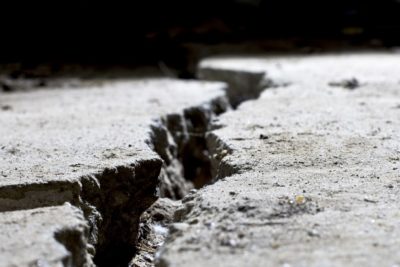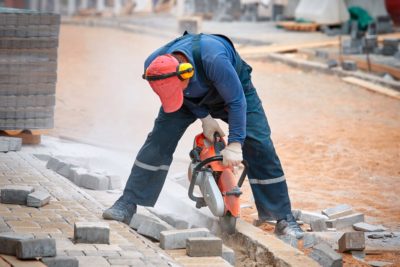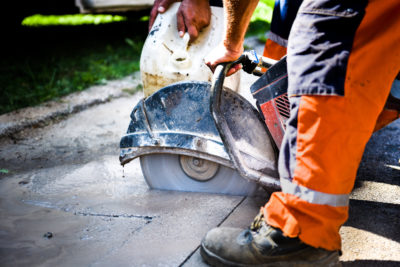Concrete saw cutting can be an abrasive and stressful process to say the least. Concrete can be a dream when you need a resilient and weather-resistant surface, but a nightmare when you need to modify or remove it.
If you’re cutting your own concrete slab for an upcoming DIY project, believe us when we say it doesn’t have to be a nightmare. Alleviate your anxiety and stress of working with concrete for your upcoming project by understanding the process of how to cut it. The key to making any DIY project easy is to understand the task at hand.
In this article, we will walk through the 15 easy-to-follow steps on how to successfully cut concrete, as well as some do’s and don’ts of concrete construction work. Guarantee success in your project and keep on reading below.
Why Would You Need To Cut Concrete
If concrete is supposed to be a near-permanent material, why would you ever need to cut it? Shouldn’t it just be set and forget? Absolutely not. In fact. There are a good few reasons why you might have to cut concrete, and many different concrete sawing applications. Some of these reasons include, but are not limited to:
- Reshaping and repurposing concrete slab length and concrete slab thickness for patios and brick paving.
- Demolition of concrete structures
- Creating expansion joints in flooring to prevent cracks
- Creating channels for plumbing and electrical wires
- Repairing concrete work for sewer lines
- Repairing sections of concrete for masonry work
- Garden, patio and residential landscaping
What Is The Best Kind Of Concrete Saw For The Job?
There are many different types of concrete saw cutters that you should consider. What tool do you use to cut concrete/ what is the best blade to cut concrete with? The truth of it is that it completely depends on your specific project specifications. There isn’t one universally appropriate concrete saw blade. For the best recommendation, you should ask a qualified concrete cutting technician.
Usually, things like bandsaws are too flimsy and weak, so they are prone to breaking. Circular saws and chainsaws are the most popular option. There are also some characteristics of a good concrete blade that you should consider. They include:
- A higher rotation rate means more power for cutting through resilient and dense material
- Smaller surface area contact means that there is less friction and in-turn, less power lost
- You should have a consistent spinning motion
- Accurate control
What Are The Dangers Of Cutting Concrete Yourself?
Operating any power tools, whether it be an electric whisk or a diesel powered diamond blade concrete saw, has potential dangers and safety precautions you should take. The difference is the concrete saw is far more powerful so the potential danger is far more significant. Some of the dangers include:
- Ruining your project with incorrect cutting, costing a lot of money to fix it
- Shrapnel flying at high speeds that can damage your face and eyes
- Highly toxic carbon monoxide fumes
- Silica dust in the air from the concrete which can cause cancer and more
- Overheating
- Recoil from the tool that can sever limbs or worse
Outside of wearing personal safety gear, if you want to make sure you avoid any of these potential hazards, the best thing to do is to understand the process of concrete cutting, as well as some of the most common mistakes. The other sure-fire way is to hire a professional concrete cutter for your project.
Wet Cutting Concrete vs Dry Cutting Concrete
Wet and dry concrete cutting refers to methods of dust extraction/ways to keep silica dust out of the air.
Wet concrete cutting is reserved for larger projects, and has water constantly running over the blade of the saw to settle the dust being produced, and keep the blade from overheating.
Dry concrete cutting does not need water run over the blade, and uses vacuums to extract dust. Even though you do not need water on the blade, it is always a good idea to wet the concrete you are cutting first. Dry concrete cutting is good for quick and small projects.
Silica dust, as mentioned above, can be extremely harmful to you, and it can even cause cancer. Even with extensive exhaust and perfect wet or dry concrete cutting, you should be using a ventilator.
The 15 Step Process To Cutting Concrete
Hopefully you now know the where and when of concrete sawing, as well as the importance of appropriate personal safety. Now it’s time to get into the how. Here are the 15 steps you need to follow for a successful concrete cut.
Get Prepared
- Scout out the area you are working in. Does it have good ventilation? If it doesn’t make the appropriate arrangement by opening windows or using vacuums.
- Arrange all of the protective gear you will need. Eye protection, thick clothes, gloves, steel capped boots. Don’t assume you will be fine with the bare minimum!
- Read the manufacturer’s instructions for the saw you are using. Make sure you understand the specifications and do not overwhelm the saw you are using.
- Measure out exactly what you are cutting and where. Then do it again to be sure.
- Once you have measured exactly what you are cutting, use a straight edge and some chalk to mark out what you are cutting.
Cutting The Concrete
- Time to fire up the saw. Turn it on, and make sure your water supply, or vacuum is working properly.
- Usually concrete saws will have two grips, one at the front and one at the back. Put your less dominant hand on the forward most grip, and your dominant hand on the back grip.
- Don’t just go in head first and start cutting. Make small, light cuts in the concrete along your chalk line to make a channel for the saw to cut through.
- Then start your deeper cuts. Apply constant and light pressure to let the saw do the work. Use the front handle to guide the saw and the rear handle to push. Keep the saw on a low speed, only increasing if needed.
- If working on horizontal concrete, don’t push down with the saw. Let the weight and gravity of the saw do the work.
- Take regular breaks to keep an eye on dust build up and debris. If the saw, or your cut, looks like it needs to be cleaned, it probably does.
After Cutting Care
- If there is any stubborn material left on the cut, use a hammer, chisel, or other bashing tools to remove it. Then use a wire brush to round off any sharp edges.
- Clean your working area. Don’t take your ventilator off yet, because there could still be airborne dust about.
- Follow the manufacturer instructions on how to clean, dismantle and maintain your saw.
- And just like that, your project should be done. Congratulations!
Do’s And Don’ts of Cutting Concrete
Do
- Use a concrete specific saw
- Wear safety gear
- Use water on the blade
Don’t
- Force the blade to cut
- Cut concrete that is under load
- Use the saw for more than 1 minute without a break
- Cut through concrete that has embedded steel and is reinforced
- Bend or twice the blade when cutting
When Do You Need A Professional To Cut Concrete For You?
Whenever you’re doing renovations in Australia that exceed $20,000 in value, that is classified as building work, and you will need a registered builder to do it. Additionally, you will need a qualified professional to do your concrete cutting if the work will affect plumbing or electrical work.
The other reason you would need a professional to do your concrete cutting is if you aren’t feeling confident enough to do it yourself, or you simply don’t want to. Concrete cutting can be easily stuffed-up, which can put your wallet, and your life in danger. To get your project started without any concern, organise a professional now.
Hiring A Professional
When it comes to concrete work, you will almost definitely want to hire a professional if you are not sure-handed to maximise the health of your concrete. You want to make sure there will not be any problems with your project.
Diamond Cut Concrete provides some of the best solutions for concrete in Perth. This is because Diamond Cut Concrete offers a 24 hour customer service line and can provide you with a quote within a day. We have completed close to 1,000 successful projects and have a 100% clean safety record. For any concrete project solutions, contact us today!



